For the ability to review this camera Nikon D7100 body gratitude to the network of stores "Paparazzi", where you can purchase this camera and other photo equipment - http://www.fotomagazinpaparazzi.ua
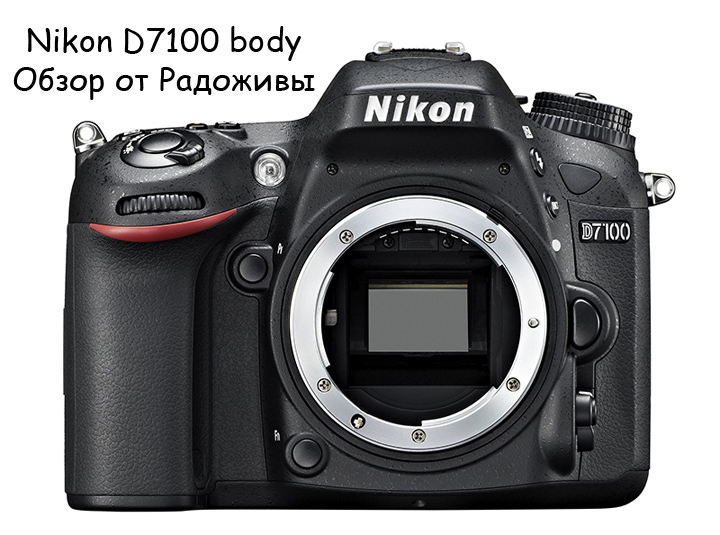
Nikon D7100 body review
Nikon D7100 is a very interesting camera, it is a fresh breath of air among cameras Nikon DX Series. An absolutely new one with a standard lens came to me to review the Nikon D7100 Nikon 18-105mm 1: 3.5-5.6G ED Nikkor VR AF-S SWM DX IF Aspherical. This review provides information on the camera itself. Nikon D7100 body.

Nikon D7100 rear view
Matrix Nikon D7100
Nikon D7100 uses a 24.7MP sensor, only 24MP is effective, which allows you to take pictures of 6000 * 4000 pixels. Sometimes they indicate a size of 24.1MP, but these different numbers 24.7, 24.0, 24.1 do not matter, anyway, the picture is created using 24.000.000 pixels, so I will talk strictly about 24MP. Most likely, the Nikon D7100 uses the same matrix as the Nikon D5200 и D7200. A complete list of all used sensors (matrices) on the Nikon central control center can be viewed here. True, due to the different matrix body kit and different processing of the output signal, in the end we can get a different image. Now megapixels you won’t surprise anyone, and they are not always so useful, I advise you to look into my section Battle of Megapixels.
The main feature is not 24MP matrix, but lack of an optical low-pass filter in front of the matrix (OLPF - optical low-pass filter, LPF - low-pass filter). Speaking very roughly, the absence of an OLPF filter will help to squeeze the maximum sharpness out of the lens and get the maximum details in the photo. I wonder why the camera was not called Nikon 'D7100E' after Nikon D800E.
The camera can use ISO 100-6400 and expand its value to ISO 25.600 (ISO HI2). There is no great benefit from ISO Hi1, HI2, it is also strange that the Nikon D7100 does not use ISO 50 (Lo 1) how to do it Nikon D600, D610, D800, D800E, D4, D4s an extra ISO stop would be nice. Nikon D7100 works very well with ISO auto control function and can independently select the desired shutter speed for each lens. In automatic mode excerpts for the Auto ISO function, 5 steps can be set for fine tuning, from a shorter automatic excerptsup to a longer automatic excerpts. You can also set the range of the automatic ISO, for example from ISO 800 to HI1.
Another hallmark of the Nikon D7100 is dotted white balance in live view. The function is very useful and you need to get used to it. In Live View, just select white balance PRE, hold down the WB button and wait for the yellow rectangle to appear, moving the rectangle, you need to set it to the point at which measurement will be performed white balance. To measure in this selected zone, you need to press the shutter button, while the camera will not take a picture, but only take a measurement BB.
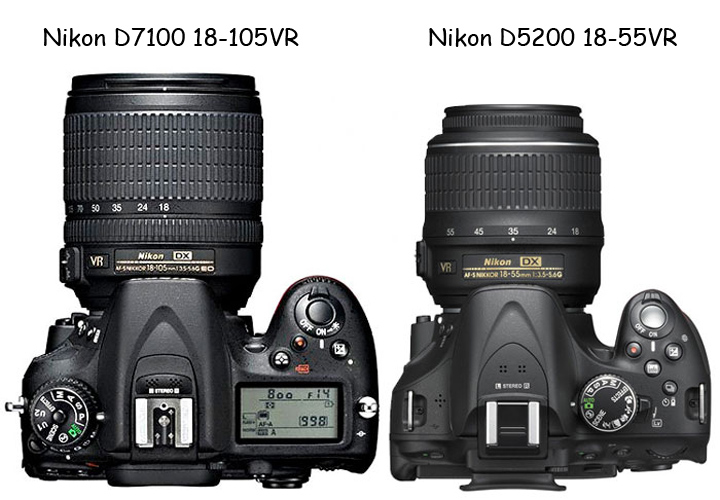
This is how two cameras look like - Nikon D7100, Nikon D5200 with similar matrices
Nikon D7100 Focus System
Nikon D7100 uses an updated focus module Advanced Multi cam 3500DX with 51 focus points, 15 of which are cross-shaped. Rumor has it the Nikon D7100 is small Nikon D4. Do not believe it. Although Nikon D4 and Nikon D7100 use 51 focus points, they have different focus modules. Nikon D7100 uses Advanced Multi cam 3500DX, While Nikon D4 - Advanced Multi cam 3500FX. The difference is that Nikon D4 can focus with F / 8.0 lenses using 11 points, and the Nikon D7100 using only one point. I have written in more detail about the focus modules here... Still, Nikon D7100 has a paper focusing module that looks better than Nikon D300, D300s, D3, D3s, D3x, as it can work with dark F/5.6-F/8.0 lenses with a single center focus point. To put it bluntly, the D7100 should focus better in poor lighting conditions. In fact, I did not notice much difference.
It's very nice that the Nikon D7100 good viewfinder coverage with focus points, same as Nikon D300, D300s. And most importantly, when working in 1.3x mode, coverage with focus points becomes simply wonderful. Even Nikon D2xs cannot boast of such a high-quality coverage of the focus area in its High Speed Crop mode. In fact, the quality of tracking moving objects in focus, the ability to compose a frame, etc., depend on the coverage area with focus points.
Nikon D7100 performs very well in dynamic focus area selection mode. In this case, 9, 21 or 51 focus points can be used. I advise you to play around with these modes. Another important method of autofocus is the 3D tracking function, which is very useful for shooting objects moving in the frame. 3D tracking works in tandem with the metering system exposurethat can recognize the type of scene being shot and improve the performance of the auto focus system.
Nikon D7100 has fine tuning of focus. You can also set the priority of the focus mode for AF-C, AF-S, in more detail about focus adjustment on Nikon cameras you can find here. Of course, the Nikon D7100 has a built-in focus motor that allows you to use a bunch of lenses AF type.
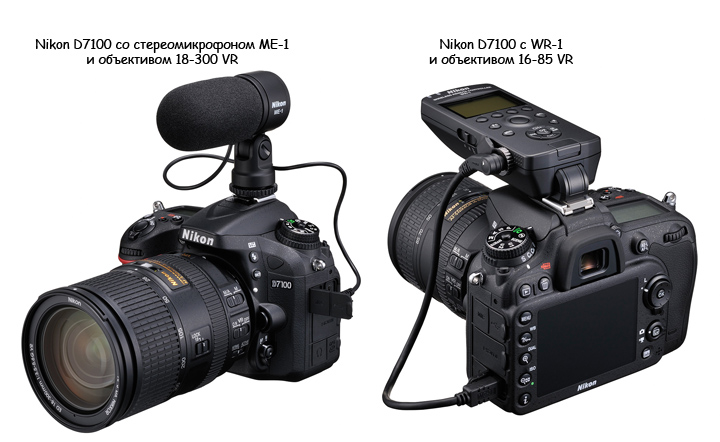
Optional Accessories for Nikon D7100
Crop mode 1.3x
The Nikon D7100 came up with one tricky mode of operation. You can shoot using the entire area of the sensor in the normal DX mode (24 x 16 mm), or you can select the crop mode 1.3 x (18 x 12 mm). In 1.3x mode EGF lenses equals FR multiplied by 2. For example, if you install fifty dollars on the Nikon D7100 Nikon 50 mm f / 1.4G AF-S Nikkorthen EGF becomes equal to 100 mm. This is logical, because 1.5 x 1.3 \u1,95d 2 (approximately 1.3). This mode can save some money for those who like to shoot from afar. In XNUMX mode, you can take pictures 4800 by 3200 pixels (15.3MP)That is enough even for serious post processing. Personally, I liked the mode because of the increase in the coverage area with focus points and the increase in shooting speed up to 7 fps. By the way, this mode also works when shooting video.
1.3x mode the inactive area does not darken in the viewfinderfor example in the camera Nikon D2xs in the high speed crop mode, the inactive area is darkened, this increases the usability of such a cropped mode. To start the 1.3x crop mode, just press the INFO button and select DX <-> 1.3x there.
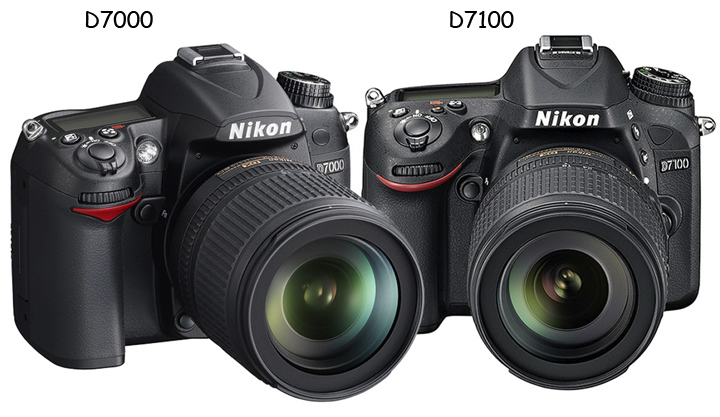
Two brothers - Nikon D7100, Nikon D7000 with 18-105 VR lenses
Nikon D7100 Speed
The camera can shoot at a speed 6 frames per second, the predecessor had the same speed Nikon D7000. But there was an opportunity expand the shooting speed to 7 frames per second in 1.3x mode.
Attention: 7 frames per second in 1.3x mode is only available when shooting in JPEG or RAW 12 bit, only 14 fps is available in RAW 6 bit mode.
Attention 2: in normal DX mode, 6 frames per second is only available if RAW 14 bit mode is turned off. If you shoot with RAW 14 bit quality, then the maximum speed is only 5 frames per second.
In total, with the best image quality (RAW 14 bit, RAW 14 bit + JPEG), the shooting speed is lower than that of Nikon D7000 with the same settings. Where is the world heading?
In general, this speed will be enough for almost any situation. 7fps is pretty good, but still not 8fps like older models Nikon D300, D300s, D700.

Nikon D7100 with battery pack and 16-85VR lens
Buffer
The buffer at the camera is small. With one memory card, if you turn off all additional functions that improve the quality of pictures, such as
- Active D-lighting
- Auth. distortion management
- Under. noise for lengths. exposure.
- Under. noise for high. ISO
- Auto ISO
That in JPEG mode is placed in the buffer
- 9 shots, JPEG L optimal quality
- 12 shots, JPEG L size priority
- 12 shots, JPEG L optimal quality in 1.3X mode
- 15 shots, JPEG L size priority in 1.3X mode
- about 4-5 JPEG pictures L Optimal quality with all additional functions switched on at maximum at ISO HI2
RAW:
- 6 shots, 14-bit, lossless compression
- 7 shots, 14-bit, conventional compression
- 7 shots, 12-bit, lossless compression
- 8 shots, 12-bit, conventional compression
- 7 shots, 14-bit, lossless compression, 1.3x mode
- 8 shots, 14-bit, normal compression, 1.3x mode
- 8 shots, 12-bit, lossless compression, 1.3x mode
- 10 shots, 12-bit, normal compression, 1.3x mode
- 5 shots, 14-bit, lossless compression, DX RAW + JPEG L quality priority
- about 3-4 snapshots, 14-bit, lossless compression when all additional functions on ISO HI2 are turned on to the maximum
It turns out that the maximum buffer can hold in RAW format only 10 shots, and with the best shooting quality '14 -bit, lossless compression '- the buffer contains total 6 shots. Due to the fact that the pictures are very heavy, the camera after 6 pictures in RAW (NEF) format will not take the next frame until it writes at least one picture to the memory card from the buffer. With my ADATA SDHC 32GB class 10 card, the camera pauses for a long time while shooting. I checked if using two memory cards, this does not save the situation with the camera stopping during serial shooting. In order to maximally prolong burst shooting, you should use the fastest memory cards, or shoot in JPEG.
RAW files with 14-bit color depth, lossless compression in DX mode weighs up to 40MB. Unlike professional cameras, such as Nikon D300s - Nikon D7100 cannot use uncompressed RAW format. For huge, heavy files on the camera, you can find two nests for cards of type SD, SDHC, SDXC UHS-I... You can set up work with cards for:
- Overflow. When the first card is filled, recording is made on the second.
- Reservation - the same picture is recorded on both cards. Very useful for capturing very important events, where you need to ensure that the data is not lost in any way.
- Record RAW on one card, and JPEG files on another. Just a convenient feature.
Nikon D7100 shows off its super performancewhich he gets through the EXPEED 3 image processing system. Roughly speaking, EXPEED 3 is the processor that does all the calculations in the camera. But in fact, this EXPEED 3 cannot squeeze out 6-7 fps at 14-bit color depth. If EXPEED 3 is as good as they write, then I could have worked hard and removed this limitation without spoiling the overall good camera performance.
It's strange for me that Nikon cannot normally solve the speed problem with 14-bit color depth, this problem is still very acute in models Nikon D300 и D300s, forcing them to work at a snail speed of 2.5 frames per second. And then she migrated to Nikon D5300, D5500 и D7200.
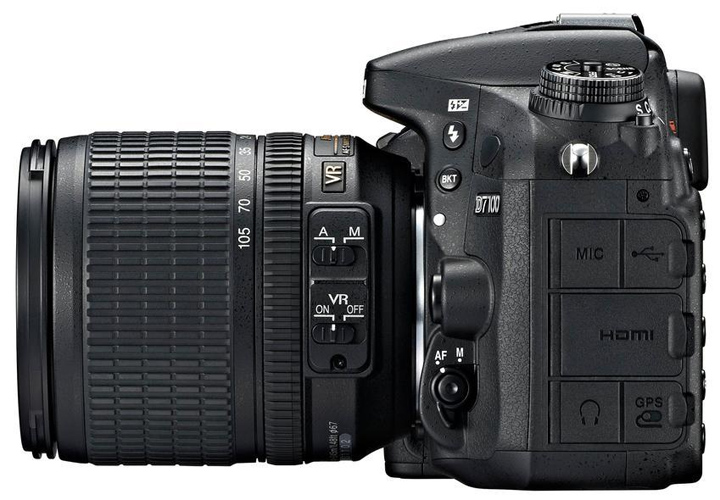
Nikon D7100 with 18-105 VR side view. Plugs for different connectors on the camera.
Shooting, metering system, turn-on speed
Can be shot at shutter speeds from 30 seconds to 1 / 8000 withit’s good that the Nikon D7100 has no stripped down excerpts in 1/4000 s, which is set to Nikon D600. The camera shutter must work at least 150,000 cycles - pretty good for an amateur camera. Also, Nikon D7100 uses independent control of the mirror and apertureThis allows a very small shutter lag. The lag is only 0,052 s... Unlike many cameras, the Nikon D7100 may not lower the mirror to capture the frame in Live View - it will simply release the shutter. In other cameras, for example Nikon D90, D700 responsible for controlling the mirror and aperture general mechanism, which operates in a standard cycle and the Live View should always lower the mirror, only after which shooting can be performed.
Measurement exposure based on 2016-pixel RGB sensorsame as cameras D600, D7000, D5200. In more detail about measurement exposure can read here. The camera can easily work with non-chip lenses, for example, with old AI-S lenses or with Soviet lenses. You can configure the soft key to quickly select a lens from the list.
With one battery charge, the camera can easily squeeze over 1000 shots. The number of photos that can be obtained on a single battery charge depends on many factors. By the way, the EN-EL15 battery itself is exactly the same as that of Nikon D800,D800E, D600, D610, D7000.
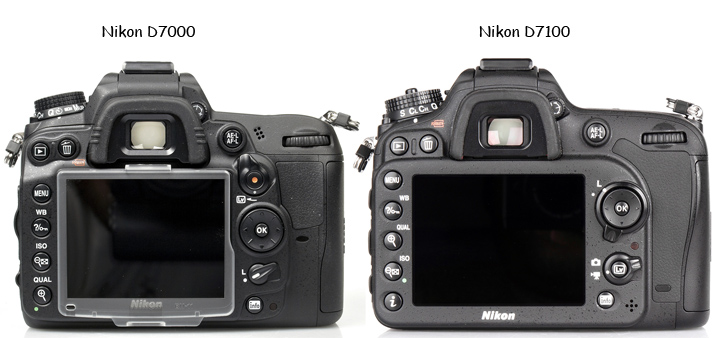
У D7000 there was a cover for the display :)
Video
In normal mode, you can shoot with a maximum quality of 1920 x 1080; 30p, 25p, 24p or 1280 x 720; 60p, 50p format H.264 / MPEG-4 AVC. It is important that in 1.3x mode you can shoot video with quality 1920 x 1080 60i, 50i... You can choose high or normal video quality. It's also nice that the Nikon D7100 has a built-in stereo microphone. In AF-F focus mode, continuous focus tracking is available when shooting video, tracking focus works just awful, When recomposing an AF-F frame, it often does not respond at all. Recording video on a DSLR camera with auto focus is a very unpleasant task for me, it’s better to use manual focus when shooting a video.
To shoot video, you must set the Live View lever to 'camcorder' mode. Recording is done using the red button next to the shutter button. It is possible to record video via HDMI to an external device without video compression, and work via HDMI with a large TV while Live view is on. There was no HDMI cable in the package, I really wanted to, but could not test this function to the level of its convenience.
In the manual control mode of the camera 'M', shooting video with manual control is available excerpts and ISO. Exposure can be set from 1 \ 30 to 1 \ 8000 seconds. When shooting a video, you can immediately change the ISO value. It is convenient to shoot video in manual mode and the Auto ISO function is on. In P, A, S modes, you can shoot video and make corrections exposure for video using the '+ \ -' button on + -3 ev In other scene modes, correction exposure not available.
Attention: while recording a video do not change aperture value, which will be filmed, therefore, you need to set the aperture value before turning on Live View.
Display, housing
Nikon D7100 has a new display with 1.229.000 points and measuring 3.2 inches (8cm). The number of dots on the display of the Nikon D7100 is even higher than that of the Nikon D4 / D4s, D800 / D800E, D600 / D610. It is also very important that the display itself is made on the basis of an RGBW matrix. Prior to this, the display matrix was manufactured using conventional RGB pixel technology (red green blue - red, green, blue). The new technology allows for better display of information in bright light.
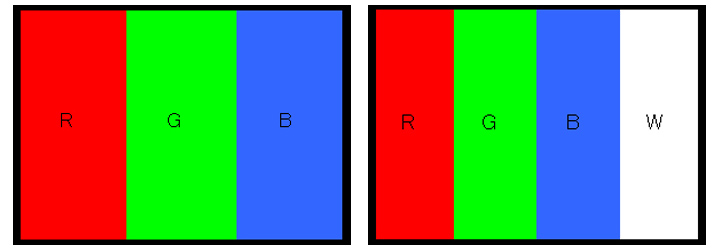
New matrix on the display Nikon D7100
The display of the Nikon D7100 turned out really шикарный. But the display does not have a protective cover, such as Nikon D90, D700, D7000.
That's not all, the new Nikon D7100 uses information display in the optical viewfinder. Now bottom info bar glows white, not green, new organic EL technology has improved the perception of information in bright shooting conditions and reduced the 'brakes' of such a display in cold weather.
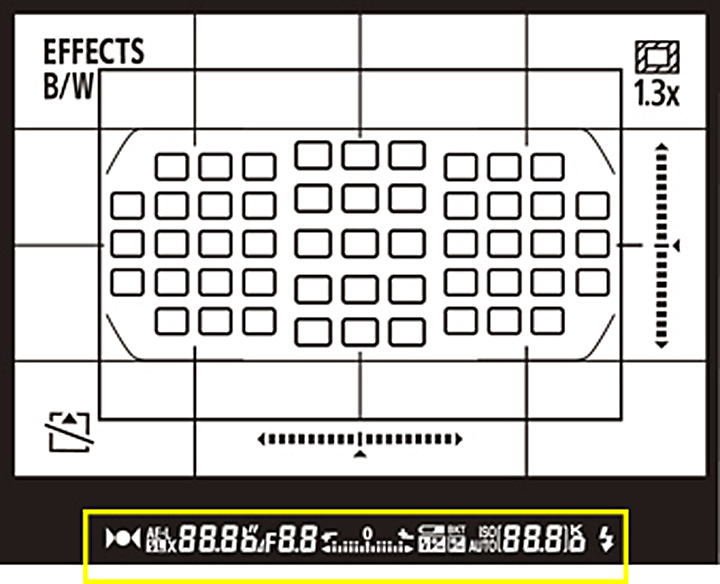
Indicators of a new type based on EL are shown in yellow
The case at the camera is half done magnesium alloy. The case has special rubber seals. The most important thing Nikon D7100 has weather and dust protection, it is alleged that camera security is no worse than D800, D300s. The camera is pleasant to the touch, well assembled. The front and rear control dials are rubberized. The camera has a comfortable grip. In severe conditions, I did not test the camera :), but for complete dust and moisture protection, appropriate lenses are needed. I don’t know where to look at the list of dustproof or waterproof Nikon lenses.
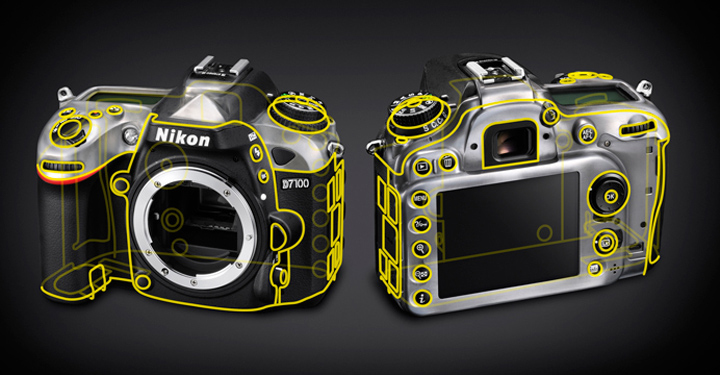
Housing Nikon D7100. Yellow seals for weather and dust protection
Weighs a 765g camera with a battery.
Sample Photos
All photos were shot on a Nikon D7100 and lens Nikon 85mm f / 1.8D AF Nikkor. Photos without processing, on-camera JPEG Fine L, VI, only reduced to 3 MP and data imprinted EXIF. Here is the original ISO 6400 image (VI, matrix metering).
Useful Features and Functions
- Active D-lighting, automatic control of chromatic aberration and distortion. True, these functions reduce the number of frames in the series, although the official website says that EXPEED 3 copes with this.
- Optional monochrome display for quick camera use. The display has a green backlight, the backlight is turned on using the camera's power button.
- HDR with different levels, you can set Moderate, Normal, Amplified, Super Amplified and Auto level. The camera takes two pictures in a row and combines them into one.
- For lovers of photo processing and shooting with various interesting filters in the Nikon D7100 installed a whole bunch of them. There are even two effects for shooting video.
- For easy camera setup without extra efforts, there are special automatic modes, such a set: Portrait, Landscape, Child, Sport, Macro, Night portrait, Night landscape, Party, Indoors, Beach, Snow, Sunset, Twilight (almost a saga :)) , Dawn, Pet Portrait, Candlelight, Flower, Autumn Colors, Products. I am often asked if a level camera is suitable for a beginner Nikon D7000, D7100 - I answer that it will do, now you understand that it will be easier for a beginner to shoot with such a huge set of automatic modes.
- Ability to use the booster MB-D15. Can connect the Nikon D7100 from the network using an EH-5b AC adapter with an EP-5B connector.
- I like very much shooting mode locks on the control wheel. Some write that this interferes with quick access to different shooting modes, but in fact this is a very useful function. Very often you can accidentally knock off the shooting mode, for example from 'A' to 'M', which can lead to a bunch of defective photos. I really missed such a blocker on my Nikon D90.
- Outputs for an external microphone, USB, HDMI, 3.5 output for headphones. Another connector for controlling the camera.
- Flash Nikon D7100 can remotely control other external flash units. You can read more in the section Nikon CLS. Nikon D7100 also supports fast synchronization with external flash units, in more detail here. Minimum sync with the built-in flash is 1/320 s.
- The camera can work remotely using the WR-1 module or the WR-R10 + WR-T10 kit, which use radio control. WR-1 allows you to remotely control almost all the functions of the camera. I did not use this device, but it should be something interesting. Also, the Nikon D7100 can use the WU-1a adapter to transfer files and control the camera using devices based on iOS, Android. And you can also use the UT-1 module to transfer data from the camera using WLAN (wi-fi). And finally, you can use the GP-1 / GP-1A to record GPS data for each shot. In short, they made a lot of new trinkets for the camera, now the main thing is to deal with them all.
- The virtual horizon in Live View and in the optical viewfinder. True, you need to try to turn on the virtual horizon in JVI.
- Interval Timer Shooting multiple exposure.
- Of course, the camera has a matrix cleaning system.
- Nikon D7100 has 3 programmable buttons, only the functions that can be hung on them are not very useful in operation.
- In RGB view mode bar charts You can view the histogram for any selected image fragment.
- You can set the center button in image review mode to quickly enlarge the image. This is a very, very useful feature. I advise you to turn it on. This is done using the f1 setting -> View mode -> Zoom on / off. -> desired magnification. The same can be done for fast Live View zoom. In shooting mode, I advise you to set the button to 'Select center. focus points. ' (the third trick is in this article).
- Bracketing exposure, white balance и ADL.
- The camera uses a pentaprism with special enlightenment in the optical viewfinder. Coverage of the field of view is 100%.
- Quiet shooting mode 'Q'. And modes for U1, U2 for convenient customization of the camera.
- The easiest method to remotely control the shutter is to use the remote ML-L3. The camera has two remote control infrared signal receivers, front and rear.
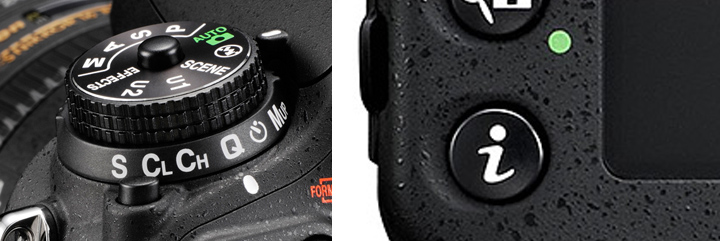
Camera wheel and new 'I' button
Nikon D7100 Personal Impressions
The camera is great, but still I expecting an heir Nikon D300s with its full magnesium body, 8 fps, and a bunch of fine useful little things, as a result received a very good upgrade Nikon D7000. Because Nikon D7100 is still namely an amateur camera. It is very strange that the Nikon D300s are not debited, but they also do not replace it. Users Nikon D300, D300s are forced to either go full frame or go down to level D7100. The same situation is with Canon, where the advanced 7D can not be replaced with a new APS-C camera. Apparently, a serious plot is being prepared against photographers who want to use the highest quality APS-C cameras.
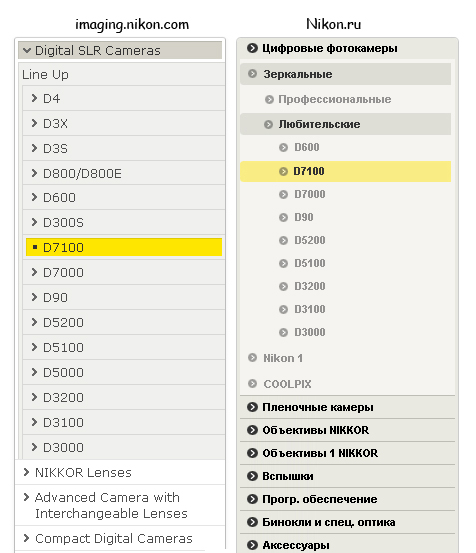
Nikon D7100 is an amateur camera, this indirectly confirms the location of the camera on the official sites
The division into classes is not only a convention, but also a huge number of subtleties, about which it is sometimes very difficult to write, but which with experience become very useful and felt in practice. Therefore, be extremely careful which camera to buy.
In general, the situation with the choice of a good advanced Nikon camera has become more acute. Of the new advanced Nikon cameras, I personally see a dilemma - either Nikon D600 / D610 with its full frame and 39 focus points in the center, or the Nikon D7100 with a cropped matrix, but with an excellent focus system and a bunch of small buns. Personally, I believe that the D7100turned out very pretty, with fewer claims than Nikon D600. And if earlier the issue of switching from D300 / D300s on the Nikon D7000 was controversial, now the D7100 should not disappoint owners D300 / D300s (though disappointing though).
UPD: many do not like the color in Nikon D7100 pictures, especially skinton (skin color in portraits). There is a specificity with color.
To whom there is little information, I advise you to look at the reviews (part in English):
- Classic review from DPreview
- Wikipedia no surprise
- The camera scored 83 points on DXO
- Here comparison on snapsort.com with the D7000 и comparison with D7000 on dxo
- Key features on the official website nikon.ru
- Noise test here и here
- Official Nikon video camera presentation
- Немного about D7100 from Kai Wong
- Lovers of boxes - froknowsphoto
- Photo examples at low ISO from the official site
- Others one reviewer
- И Ken rockwell did not pass Nikon D7100
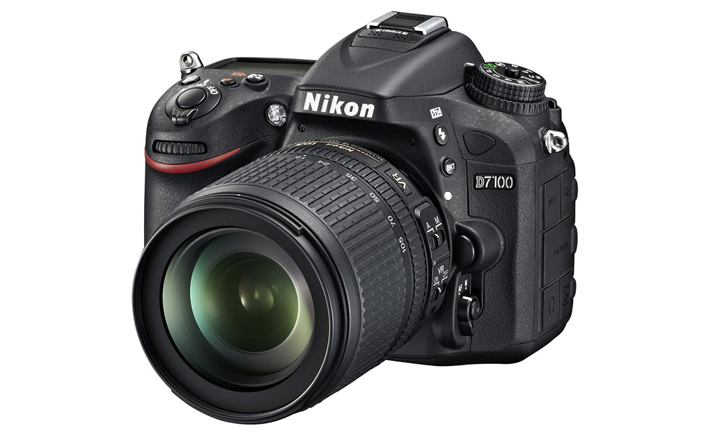
It looks like a Nikon D7100 with a standard (whale lens) Nikon 18-105mm 1: 3.5-5.6G ED Nikkor VR AF-S SWM DX IF Aspherical from the delivery
Prices for modern Nikon cameras in popular stores can look at this link.
Comments on this post do not require registration. Anyone can leave a comment. Many different photographic equipment can be found on AliExpress.
Conclusions:
Nikon D7100 - best advanced amateur DX camera for 2013 (at the time when I write a review about it). Nikon D7100 in 1.3x mode has best viewfinder coverage with focus points, does not have a low pass filter and can accelerate to 7 frames per second. Here's what's new in the Nikon D7100:
- New 3.2-inch display with 1.229.000 dots of the new RGBW type
- Spot metering white balance in real time via live view
- New WR-1 radio remote control, new MB-D15 battery pack
- New UT-1 Wireless Fast Data Device
- The new Advanced Multi-CAM 3500DX focus sensor is the first Nikon DX camera to focus with 'dark' lenses up to and including F / 8.0.
- New mechanism for separate mirror and aperture control
- The new 1.3X framing mode, which also works in video mode (before that, among DX cameras, something similar was only in Nikon D2x, D2xs)
- New i-button control (in addition to the Info button)
- The first DX camera without a low pass filter
- New organic EL display for the optical viewfinder (instead of Transmissive LCD)
In general, it turned out to be a good camera. If there is money, then as an advanced amateur Nikon DX camera recommend Namely Nikon D7100, perhaps in the choice will help here is such an article.
Material prepared Arkady Shapoval. Training/Consultations | Youtube | Facebook | Instagram | Twitter | Telegram






















MDA didn’t want to offend with the D800 proposal :), but about moire, even in the D7000 it is there and is easily obtained when photographing, for example, fabrics (the groom's jacket with a repeating pattern). I am not a great specialist in explaining how to avoid moiré, but it can be seen on the monitor, but not noticeable later when printing a picture. Would you like to take a closer look at the D300 (s), I took to shoot and I will say it is very convenient, with fast and accurate autofocus and not super-megapixel (the shake is not so scary!), And the most important thing is a professional camera at an affordable price - I look after it myself with a second camera , but finances :) :( ... In general, weddings, look, Marks are being removed)))
D300 is good, but there is no desire to buy something like that. There was only two cameras left to choose, namely Nikon cameras. probably still take 600ku.
Thank you so much for this section. It helped me understand a lot.
Arkady Shapoval
03.04.2013/10/39 at XNUMX:XNUMX Reply
Yes, exchanging d90 for d7100 already makes a lot of sense.
--------
And in the article about d7000, you do not advise changing it to d90, where is the logic? The difference between them is negligible, and this is a fact that is confirmed by everyone who has both cameras in comparison, I can give tests. And d7100 makes noise more than d90 !!! An overabundance of megapixels does not lead to good ... everything needs a limit.
The logic is that d90 and d7000 differ by one generation. D7100 in comparison with d90 is already 2 generations. The camera is not only megapixels, but a focusing system, work with old optics, for some videos, etc. Therefore, I see the point in going from d90 to d7100. These are my thoughts.
Arkady, I like reading your articles and reviews. Thank you for them!
But here you are a little wrong, generations have nothing to do with it. On the focusing system ... yes I agree, the D7100 wins, and that's all !!! To get a normal photo, you need extra short exposures, and to provide 24 megapixels you need excellent (expensive) glasses, otherwise soap is soap. What can I say, read on the market !!!
The focusing system can overcome the disadvantages in many ways. Everyone rested on short exposures - in many cases this is not a problem.
For myself, I decided -16MP is enough for an amateur. Therefore, I bought a used D7000 with a mileage of 8500 to
D90, so as not to change the lenses. In addition, it is convenient to shoot with manual and high-aperture optics 1 / 8000s.
The focusing system and on the D7000, clearly fulfills.
When buying a camera in the store, there was a choice, D7000 or D7100. Both were with whale 18-105 VR. Both are equally tuned to the same values, as a result, left the 7000th.
And the main drawback in the D7100, I want to note the noise due to inflation by the market 24Mp, and the built-in noise can not cope with them.
Arkady, once again, all the best and good luck!
Thanks. There are many subtleties, the choice is always a challenge.
The focusing system on the D7000 works of course well, you just need to adapt, i.e. from experience, to predict the moment when the system will focus (the lenses on the lens will stop) and the camera shutter should work at that moment (here it is necessary to take into account the delay between pressing the shutter button and the mechanism itself). And the 18-105 lens allows you to shoot portraits and much more at a shutter speed of 1/20 with your hands.
I'm just wondering ... and what expensive glasses are the talking about here? makrik 105 mm for nikon for 30 rubles. is it expensive or childish? …. but about the noise reduction, it also works at high ISO, I think that many people try not to raise the ISO above 000 ...
mda take d600, and do not rack your brains. The camera is super, for the wedding man, I’m not overjoyed myself! dx. glass determines even in ff mode, the range is freaky. 35 / 1.8 I do not rent !!!!
As for me, the D7100 is better in the hand.
Pleased with the ISO values in the test shots.
Good day! But I didn’t like this camera, I took it off with a whale for 18-105 and returned it back. I don’t like the quality of the photo with ISO values above 800, the very nature of the noise is friable and dirty, and the number of misses of the AF at 105 mm on the cetus at the central point was not small though the subject was not easy to light. Compared with the Pentax K-5 ii kit 18-135WR and sony nex-6 kit 18-55 OSS. The last two cameras on the quality of the photos on the ISO 1600 and 3200 liked more. Therefore, this Nikon D7100 with a whale of 18-105 returned to the store without regret!
By the way, the D7000 complete with 18-105 is “the same” in terms of noise, as Alexander noted here ... it is especially upsetting when you shoot people indoors and have “loose dirt” in the shadow areas of your face. Somewhere in the network there was a note that the D7000 is an unsurpassed noise reduction in its class - it's hard to judge how true this is ... In general, today Nikon-crops are most likely the most successful models D80-D90 and D300 (s).
Yes, full of you!
Back in 2006, the D80 was considered noisy. As its owner, I confirm. Another thing is that the noise is not loose and resembles a film grain.
I don’t have any attachment to any brand, I just choose a camera for myself. Thank you for the article, and as your shot looked at ISO 6400, I was once again convinced that I did the right thing, that I returned the camera!
Hello, there is a question for you. Help please :)
I choose between
Nikon D7000
Nikon D7100
canon eos 700d
and here a whole bunch of doubts.
especially worried about the noise on the d7100
what do you advise?
Tini
take d800 - what can you advise here? byagi from these crops!
Hello!
Test photos, in principle, say nothing ... There is not even one portrait to evaluate the colors ... skin tone ...
I ask you to make such as possible. I would be very grateful!
Look at the office!
http://imaging.nikon.com/lineup/dslr/d7100/sample.htm
Offtopic. - I remember once my picture in the mountains (I was riding a snowboard) taken on a Samsung Galaxy S phone ... Perfect drawing - because of the lighting, etc. it was optimal. Snow is like a big reflector, sun without clouds, clean air without dust ... And even more so, a DSLR will be ideal for shooting. So, according to the official test photos, everything will be tip-top.
I could not find it on the Internet, but I really need to know: how long does a video file take at its maximum duration? Or say the bitrate of the video / sound. Thanks.
Sergey, what shooting parameters are you interested in?
I mostly shoot with 1920 x 1080 quality; 30p (I prefer the best quality). With these parameters, the camera can take up to 20 minutes. At the same time, 1 minute of video takes ~ 160 Mb, 5 minutes of video is 815 Mb.
Like, crop mode 1.3x. Taking a picture, you can zoom in on the subject: it’s convenient to take close-ups. And what is good in this mode is the quality of 1920 x 1080; 60i / 50i.
Here is a screenshot with the detailed parameters of the video shot on the camera:
http://s002.radikal.ru/i197/1305/1b/673c36d6a6f4.jpg
Your opinion is purely like a photographer .. what would YOU buy d7100 or d7000?
Corp. is not a technique for the pros))) 7100 and 7000 in the furnace. if an amateur then 7000 just right
D2xs?
Yes, but what about the D300s, after all, is it a professional camera, even though it’s cropping it into the furnace too?
The difference in the pictures taken with the “crop” and with the “full” (narrow-format) frame is visible only to us, who are engaged in photography at more or less some level. 99% of the people we shoot do not notice absolutely no difference in the finished picture !!! A noticeable difference will be seen between cameras with 24x36 mm matrices and cameras with matrices, for example, 60x60 mm.
Many famous photographers shoot with Nikon D300s and Nikon D7000 (by the way, both cameras are optimally balanced in terms of “matrix size-megapixel”).
It doesn’t matter what your DX (crop) or FX (full frame) camera is, the LENS and the plot with a properly balanced composition and light are important.
Denis this answer is that !!! probably buy d7000
Arkady, what about DD for 7100?
Arkady, tell me please. Totally confused.
First, I read that all FF cameras only need top optics to resolve such a matrix. Then I read, I see the opposite opinion: that if you take FF Nikon D600, with its 24 megapixels (which is not too much for FF), then not the best glasses will work well on it. But if you take the 7100 with its cropped, but for the same 24 megapixel matrix, then there really is nothing to do with average optics. Because 24 mp for a crop is already a lot.
It turns out like this: FF is in the form of d600 and you can at least not get into big money with optics. Shoot by the fact that there is at least the first time. Or crop 7100, but buy expensive lenses. From this point of view, it is probably better to invest in 600.
It is the size of the pixels that needs to be considered. The FX matrix is 2.25 times (1.5 ^ 2) larger than the DX matrix. Therefore, with the same number of MPs, fX has larger pixels. In general, an FX camera is preferable; for more or less serious shooting, crop is a dead end.
Is it a dead end or not? Before FF appeared, “serious” filming was also carried out.
Those. a large pixel is better in terms of ... what? Noise, resolution of optics?
Before the advent of FF, there was a film, you should not forget about it. In the general case, both for noise and for weak optics.
Arkady, hello. I have d90, I think I’m going to switch to d7100. Today I took test shots in the store on d90 and d7100 with an af-s 16-85 lens. I compared it on a computer, on d7100 the pictures are darker and noisier (iso800). Why?
Edik, d7100 the camera is generally noisy, because there are a lot of pixels in the same matrix area.
The d7000 will be much better in noise and other parameters that are really important for the photo.
All Nikon lenses will be suitable for sharp images, and the D 7100 requires only expensive glass.